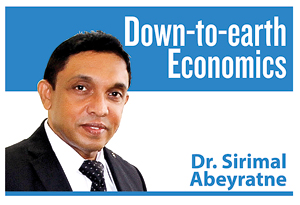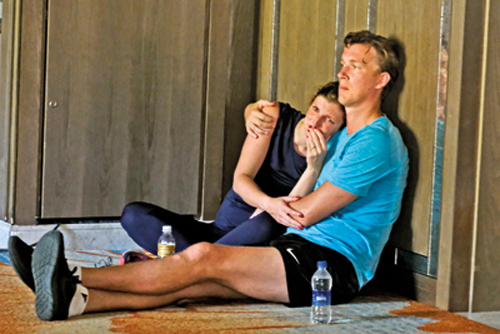Terrorism and tourism
View(s): Jayanath, with whom I had a chat a few days ago, was one of the many investors who decided to put money in building a “boutique hotel” on the sea front. Total investment was close to Rs. 1 billion. It was contributed by Jayanath and his partners as equity capital, while the balance was raised from a bank loan.
Jayanath, with whom I had a chat a few days ago, was one of the many investors who decided to put money in building a “boutique hotel” on the sea front. Total investment was close to Rs. 1 billion. It was contributed by Jayanath and his partners as equity capital, while the balance was raised from a bank loan.
The land by the beach was purchased, and the boutique hotel was put up. Employees – all together 60 employees mostly from the local communities within close proximity – were recruited and trained.
The hotel was open for business in May 2016; guests started making reservations, one by one; there was a growing number of tourists visiting year by year.
As usual, the business was scheduled to come to its break-even point of making profits only after 4-5 years in operation. Jayanath and his partners were looking forward to a thriving tourism in the Eastern coastal belt, and to reaping good returns on investment.
Eastern obstacles
For the Eastern province, it might take even longer to reach the break-even point of deriving good returns to investment as there were other obstacles too. As a maiden tourist destination, usually it might take time to promote the Eastern coast for international tourism. Even for promotion, perhaps, the major issue was the lack of physical connectivity.
In spite of the geographical smallness of the country, the physical distance to the Eastern province continued to remain a problem for people and goods to traverse. And resolving that issue might take years or decades!
For a European tourist who takes an 8 – 10 hour flight from a European destination to Colombo, provided that there are direct flights, it may not be practical to advise spending another 8 – 10 hours to reach the Eastern coast by road. The only option as at present is to take a domestic flight, which may also not be a good travel advice to most of the tourists. The 6 – 12 seater smaller planes pose many questions, including high cost per passenger.
Despite all the obstacles that are yet to be resolved, the investors saw the long-term potential for thriving tourism in the Eastern coast. They invested even if there is delay in returns to investment.
Beyond seasonal tourism
With the opening of the Eastern province for tourism as well as the changes in global tourism patterns, it is wrong to attribute tourism to a “season” today. It was traditionally considered that November – March is the peak tourist season.
It coincides with the winter season in the Northern Hemisphere where the international tourists originated from in travelling to countries like Sri Lanka. International tourism dominated by countries in the Northern Hemisphere is no longer the case today. Tourists are originating increasingly from the emerging economies in the Asia Pacific region as well. And some of these countries are generating tourists outside the traditional “peak season”.

File picture of a tourist couple soon after the blast at the Shangri-La hotel.
The local concept of peak tourist season also coincides with Sri Lanka’s tourist locations in the Western coastal belt. Given the monsoon wind patterns, the Western coast is calm and beautiful during peak tourist season. But now the Eastern coastal belt is giving birth to a new tourist season in the middle of the year, which is yet to be exploited in the years to come.
Anyway, both seasons are still about sun, sand, and sea! Tourism today is much more diverse; in fact, Sri Lanka also has the capacity to cater to more diverse tourist purposes than to those attached to tropical beaches, while such tourism has no seasons.
Thriving tourism
Similar to Jayanath’s boutique hotel, there was a large number of hotels that were put up along the Eastern coast during the same period. According to Sri Lanka Tourism Development Authority (SLTDA) data, out of the total 350 hotel projects of the entire country, all three districts of the Eastern province – Ampara, Batticaloa, and Trincomalee – together had 44 projects by the end of 2018.
As tourism was thriving after the war, there was a rapid increase in tourist arrivals to 2.3 million in 2018 from less than 500,000, 10 years ago. During this period, the number of hotel rooms in the country has increased from 14,000 to 25,000.
Both direct and indirect job opportunities have increased from 125,000 to 400,000. And tourist income from US$ 350 million to over $4 billion to become the second largest export income after textiles and garments worth $5 billion.
Easter Sunday
It was on Easter Sunday, April 21 that a wave of terrorist attacks took place in churches and hotels; one of the blasts was also at a church in Batticaloa! Ten years of peace in Sri Lanka was shattered.
As per news, hotels all around the island went without guests as there was a flood of cancellations. Tourism, much more than any other industry, is sensitive to volatile security conditions at both local and global levels. Rumours about “security lapses” were more damaging to tourism than the actual incidences.
Rich countries are today more destabilised by security threats than developing countries, but within a few days or at least within a few weeks, they are back to normal. There is no one, issuing travel warnings against them.
As all the hotels in the country experienced a wave of booking cancellations, Jayanath’s boutique hotel on the Eastern coast was no exception: It had 60 per cent occupancy rate in April, which was down to less than 10 per cent in May.
The main problem that Jayanath and his partners had to face was not the loss of hope for reaching the break-even point of returns to investment, but at least how to meet the monthly minimum expenses. Even if the rooms are kept closed, lights switched off, and food and drinks not prepared, there is about minimum Rs. 10 million expenditure per month, which does not depend on whether there are guests or not. It includes the payment of Rs. 6 million bank loan instalment, Rs. 2 million minimum wage bill and, other maintenance costs.
Multiple charges by
multiple agencies
Tourists who check-in to a hotel or dine at a restaurant were often displeased or even angry to find out that their bills come with multiple charges added to the basic cost resulting in almost 30 per cent cost increase: Service Charge (10 per cent), Nation Building Tax (1 per cent), Tourism Development Levy (2 per cent), and Value Added Tax (15 per cent).
In addition to the above, local government authorities demand 1 per cent of the turnover as trade licence; and the hotels also require Tourist Board licence and liquor licence.
It was a commendable move that this week the government decided to cut down the VAT from 15 per cent to 5 per cent but temporarily. It is necessary to do away with various charges, while simplifying and reducing the charges and taxes competitively and permanently. In addition, it is necessary to ease the burden of the tourism industry and protect the investors during this difficult time, which is only a temporary matter.
At the same time, the tourism industry needs to look at beyond the short-term: Is Sri Lanka a “competitive” tourist destination among other popular tourist destinations in Asia? Does Sri Lanka tourism actually provide “value for money” to the tourists? Given the sudden influx of tourist arrivals on the one hand, and the prevailing supply shortages on the other hand, the market is apparently distorted. As it takes time for the market to settle down, it is also better to address the above questions at policy level.
(The writer is a Professor of Economics at the University of Colombo and can be reached at sirimal@econ.cmb.ac.lk).


